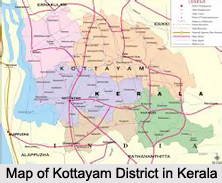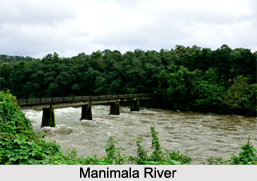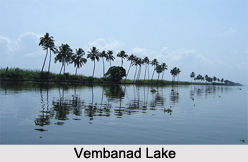 Kottayam is a place of enthralling beauty. It is bordered by the lofty Western Ghats on the East and Vembanad Lake and Paddy fields of Kuttanad on the West direction. Kottayam is a land of unique characteristics. Panoramic backwater slashes, lush paddy fields, highlands, extensive rubber plantation and an impressive amount of the literacy rates make this district distinguishable. This land also boasts the first Malayalam printing press. This was established in 1820 A.D. by a Christian missionary Benjamin Bailey.
Kottayam is a place of enthralling beauty. It is bordered by the lofty Western Ghats on the East and Vembanad Lake and Paddy fields of Kuttanad on the West direction. Kottayam is a land of unique characteristics. Panoramic backwater slashes, lush paddy fields, highlands, extensive rubber plantation and an impressive amount of the literacy rates make this district distinguishable. This land also boasts the first Malayalam printing press. This was established in 1820 A.D. by a Christian missionary Benjamin Bailey.
History:
The history behind the naming of Kottayam can be explained as kotta `fort` and akam `inside`. Thazhathangadi near Kottayam town was the administrative headquarters of the Thekkumkoor and Vadakkumkoor Kings. Vembolinadu, which was established in 1100 A.D., were conquered by Marthanda Varma between 1749 and 1754 and became part of Travancore. And as an administrative unit, Kottayam was formed in 1860 as one of the divisions of Travancore with Chertalla as its headquarters.
Geography:
The total geographical area of the Kottayam district is divided into three distinct physiographic divisions viz. Lowland, midland and high land. The altitude varies from sub mean sea level to 1 to 2 thousand feet above mean sea level. This undulating nature calls for effective land development and soil conservation practices. This is for the purpose of improving and conserves the productivity of the soil.
Climate:
Temperature varies between a minimum of 20.8°C to a maximum of 34.1°C. Climate in this district is moderate and very pleasant. Average annual rainfall is 3137 mm. The two monsoons Southwest and Northeast give a normal rainfall of 1737 mm. and 804 mm. respectively. The highest temperature is recorded during the month of April-May and this is up to 33°C.
Location:
The Kottayam district is located at North-Latitude between 9°-5` and 10°-21¹ while East-Longitude between 76°-22¹ and 77°-25¹. This place lies in the south central part of Kerala. The four boundary of the district can be mentioned as below: In the North direction there is Ernakulam, in East direction there is Idukki, in South there is Pathanamthitta and in West direction there is Alappuzha. Out of the total area of 2024 sq. km. the lowland area is 398.4 sq. km., midland area is1287.7 sq. km. and high land area comprises of 508.8 sq. km.
Water bodies:
The exterior water resources of the Kottayam district is contributed by three major rivers Menachil, Manimala and Muvattupuzha and their tributaries viz. Trikkoil, Poonjar, Chittar, Kadappuzha, Konipadathodu, etc. The Kadapuzha River originates from Araikunnumudi and Puzhavattumudi at an altitude ranging from 914 to 1097 m above Mean Sea Level. It flows to south and join the Konipadathodu to form Kalathukadavu River.
The Trikkoil River has its origin from Maradimalai, and flows southward up to Erattupetta. It can be seen that the Poonjar River starting from Thlarmalai joins the former at the same time.
The Meenachil River flows almost in the center of the district. Thus it is divided the city in to two equal halves. The other two are multi District Rivers. Manimala River has its origin from Muthavara hills in Peerumedu taluk of Idukki district and flows through the south east part of Kottayam district.
 The Muvattupuzha river is formed by the confluence of three rivers viz. Thodupuzha river, Kaliyar and Kothamangalam river.
The Muvattupuzha river is formed by the confluence of three rivers viz. Thodupuzha river, Kaliyar and Kothamangalam river.
The vembanad, the largest backwater in the state is spread to an area of 2926.77 hectares in the Vaikom, Kottayam and Changanacherry taluks. The Vembanad Lake contributes to the economy in a broader aspect. It works as a source of lime shells, inland fishing and water transport.
Demography:
According to 1991 census the inhabitance of Kottayam district is 1,82,8271. This is 6.28% of the total population of Kerala. Females slightly out number the males with a sex ratio of 1006 females for 1000 males. The total male population is 912860 while the female figure is 915411.
Out of the total population 7.43 % belongs to the scheduled castes and 0.98% to the Scheduled Tribes. The density of population is 833 people per kilometre against the state average of 749. The number of households in the district is 3,61,811. The literacy rate of the males is 97% and that of the females is 93%, all together which constitute an average of about 96%. Kottayam has the highest distinction of being the first town in India to achieve 100% literacy.
Agriculture:
The agriculture of Kottayam district includes plantation and horticulture. In plantation paddy is important while in horticulture rubber, coconut, pepper, cocoa, pineapple, etc. are important. There is a vast cultivation area, which is utilized fully in this district.
Paddy:
Paddy is the important crop at the low land area. Usually hybrid seeds are cultivated here. The total area under cultivation is 24695 hectares. The area besides the Meenachil and Vembanad rivers are below the sea level and forms part of the Kuttanad belt. The paddy fields at Pallom, Ettumanoor, Kaduthuruthy, etc. are known as `upper` Kuttanad.
Rubber:
The 60 % of the total cropped area is used for rubber cultivation, which is estimated to be 107647 ha. Kottayam accounts for 25% of the entire rubber plantation in the country. This is because of the fact that the agro-climatic condition in the district is best suited for rubber plantation.
The entire district, barring a few villages in the low land region, lying close to Vembanad Lake, is found to be suitable for rubber cultivation. Rubber Board Head quarters and Rubber Research Institute of India (RRII) are present in the district, that can be one of the factors for the promotion of rubber here. It is the only agriculture crop that provides an assured and steady income to the farmer.
Coconut:
Coconut is the second important crop being cultivated in 41531 ha in the district. The area under coconut had been recording a steady decline over the last two decades. In 1981-82 the total cultivated area for coconut was 51,115 ha and in 1993-94 it minimizes to 41,531 ha. The cultivation of coconut is mainly confined to three taluks viz. Vaikom, Kottayam and Changanassery, comprising the low lands and rubber is replacing a midland.
Pepper:
Pepper is also an important crop in the district. The crop is mostly found in the mid and high land portions of the district. Pure crop plantations are not very common in the district. The pepper has a prime place in the economy as because this is the most important export commodity. But the highly fluctuating prices and the `Quick wilt` disease has discouraged the farmers from the expansion of the crop. It has declined radically like in 1981 it was 12,868 ha while in 1994 it was 8,783 ha.
Cocoa:
Cocoa is cultivated in total of 2,827 ha in the district. The area under crop had been declining or decreasing due to the high demand of rubber plantation among farmers. However, the crop is still found to be a viable inter crop among coconut and areca nut gardens. Recently farmers are getting better prices for cocoa. So it is likely to pick up in future especially in low-lying areas.
 Pineapple:
Pineapple:
Pineapple is another horticulture that is popular in the district. The present area under pineapple cultivation is estimated around 783 ha. The crop is both taken as pure crop and mixed crop. The crop is recommended for inter cropping in the young rubber plantations. It is also possible to take the crop in the boundaries of other crop provided sufficient sunlight is available in that area. For its cultivation proper sunlight is important.
Industry:
Industrial scenario:
Rubber is the most important agricultural product in the district. There is abundant scope for large number of rubber-based units in the district. As of now, about 15% of the SSI units or small-scale industries units are rubber based. But about 75% of these units are concentrated on 5 items only, as against about 35000 products possible with rubber. With the establishment of the proposed tyre factory viz. Palazhi tyres in the co-operative sector, the rubber based industry is likely to be boosted up. Similarly there is also scope for more wood based industries, engineering industries and garments units. The coir and handloom industries in the district are also running successfully.
Artisan and decentralized units:
The exact number of the artisan and other decentralized units in the district is not available. Although it is understood that there exist a number of artisan units like black smithy, carpentry and gold smithy in the district. It is estimated that there is scope to establish about 500 units under this sector every year.
Cottage and village industries
Mainly the Khadi and village industries commission or KVIC and khadi and village industries board or KVIB promote cottage and village industries. The khadi and village industrial board or KVIB has an office at Kottayam. There are about 94 industries, for which assistance is given by this KVIB. These industries are labour intensive and involve less capital. Apart from KVIC and KVIB, the village and cottage industries are also promoted under Government sponsored programs like IRDP, PMRY, etc.
Small-Scale industries:
In the month of March, 1996 there were 15009 registered Small Scale Industries or SSI units in the district. Of this, 1730 were registered during 1995-96. There are a various number of positive factors for the development of industries in the district, which helps a lot in the economy. The major factor is the availability of raw material, manpower and ready market. However, there are also a few constraints that pull back the industrialization process.
Raw material based industries:
The most important feature of the district is the availability of natural rubber in plenty. It is estimated that Kottayam district alone accounts for 25% of the total production of natural rubber in the whole country. Rubber is the major raw material for about 35000 different types of products, which are, produced here in a huge amount. This can also help in setting up of more rubber-based industries. The rubber board and rubber research industries of India are present in this district, which is a supplementary advantage for its production.
Presently, there are about 2000 rubber-based industries in the district. It accounts for the largest share in the total industries considering the availability of the raw material. There is a proposal to set up a large type factory at Pala, which can enhance industrial activity in the district as well.
Traditional industries:
Wood based industry:
Other than rubber, wood is another major raw material, which is available in the district. A variety of quality timbers are available locally. This can also collect from the neighboring district. Recently, the processed rubber wood has been gaining popularity for furniture making, interior decorations and even as construction material. There is a tremendous potential for establishing rubber wood processing units. There are about 1300 wood based industries in the district, which are very useful for the production of rubber.
Agro based industries:
Agriculture is the major economic activity in the district. About 50% of the net domestic product of the district is contributed by agriculture and other primary activities. Processing of these products can be a major industrial activity in the district. Some of the major agriculture products which are available in this district can be named as rubber coconut, vegetable, paddy, spices, pineapple, pepper, ginger, milk, meat, fish, etc.
Demand based industries:
The whole district of Kerala is a consumer state. Most of the items required are being imported from the neighbouring states. The situation in Kottayam is not different. This being the situation, there is a ready market for most of the products that can be produced in Kottayam. A survey conducted by KITCO in 1994 revealed that about 64% of the industrial products, have good market within state itself.
The demand based industries possible in the district are garment making, plastic product, automobile products, metal and non metal industrial products, food and beverages, paper and printing units, building/construction materials, leather goods, repair units, etc. It is observed that there is a high demand for consumer non-durable articles.






